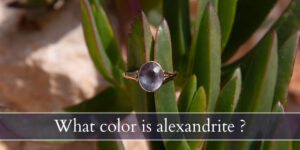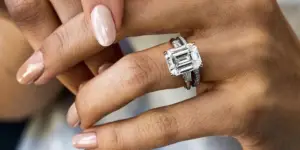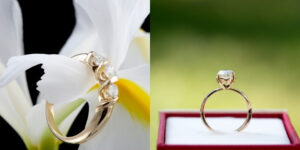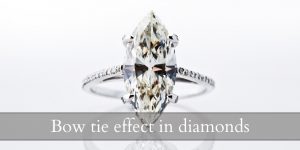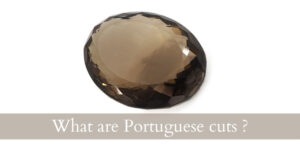Wondering if there’s something better than the brilliant cut ? Well, there is a third style, aside from brilliant and step cut: the rose cut. These diamonds are very difficult to find, especially in ready-made rings, so they’re a bit of a treat when you do source a loose rose cut! Let’s take a look and see how they compare to brilliant cuts, and whether they’d be the most charming option for you.
Brilliant cut vs rose cut
Brilliant cuts are modern diamond cuts designed to maximize sparkle by adding more facets, while rose cuts are an antique cut style that has less facets and often a very flat back (where the pavilion would be). Rose cuts are more subdued and do not really sparkle, while brilliant cuts are designed specifically for maximum sparkle and light performance.
It’s far easier to source a brilliant cut than a rose cut, but this also makes rose cut engagement rings stand out form the crowd. Rose cuts look far larger than any brilliant cut, because they are so spread out, and due to their large, few facets will immediately show any color or clarity issues while a brilliant cut might help hide them.
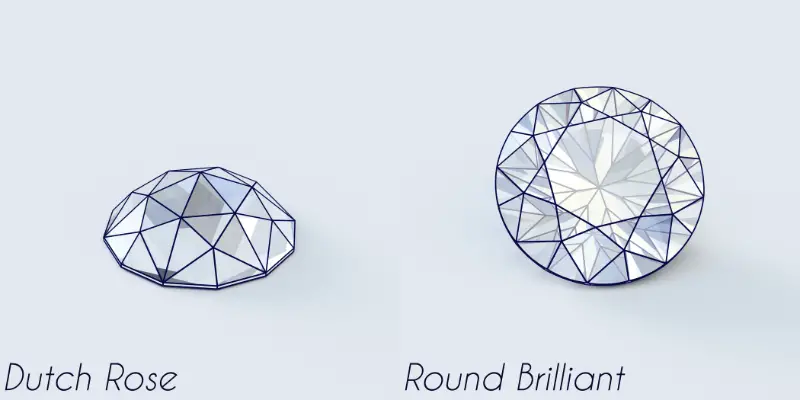
What is the brilliant cut ?
Brilliant cuts are a type of diamond cut that focuses on bringing out a diamond’s sparkle, with the aid of many tiny facets. The most notable version is the round brilliant, the one you will usually see in engagement rings. While brilliant cuts can be applied to any shape (oval, marquise, cushion, radiant, pear, etc) it’s the round brilliant that is most well known.
This cut style was developed specifically to get the most sparkle possible out of a diamond, as opposed to the step cut which gives diamonds wide flashes of light (both white and rainbow colored). This difference is largely due to the number of facets and their size. Smaller facets have smaller flashes of light, resulting in more of a glitter effect.
For the sake of fair a comparison between rose and brilliant cuts, we will be referring to round brilliants in this post, unless otherwise noted.
What is the rose cut ?
Rose cuts are more of a style of cut, rather than a specific shape. Most of the time it refers to a round shape, but the cut style is a flat bottom and a domed crown, with many facets on the crown. There is no table, the crown comes to a point. The facets are triangular and large, especially in the middle where the table would be, and they get smaller as you near the girdle. In some ways the rose cut is a middle ground between brilliant and step cuts.
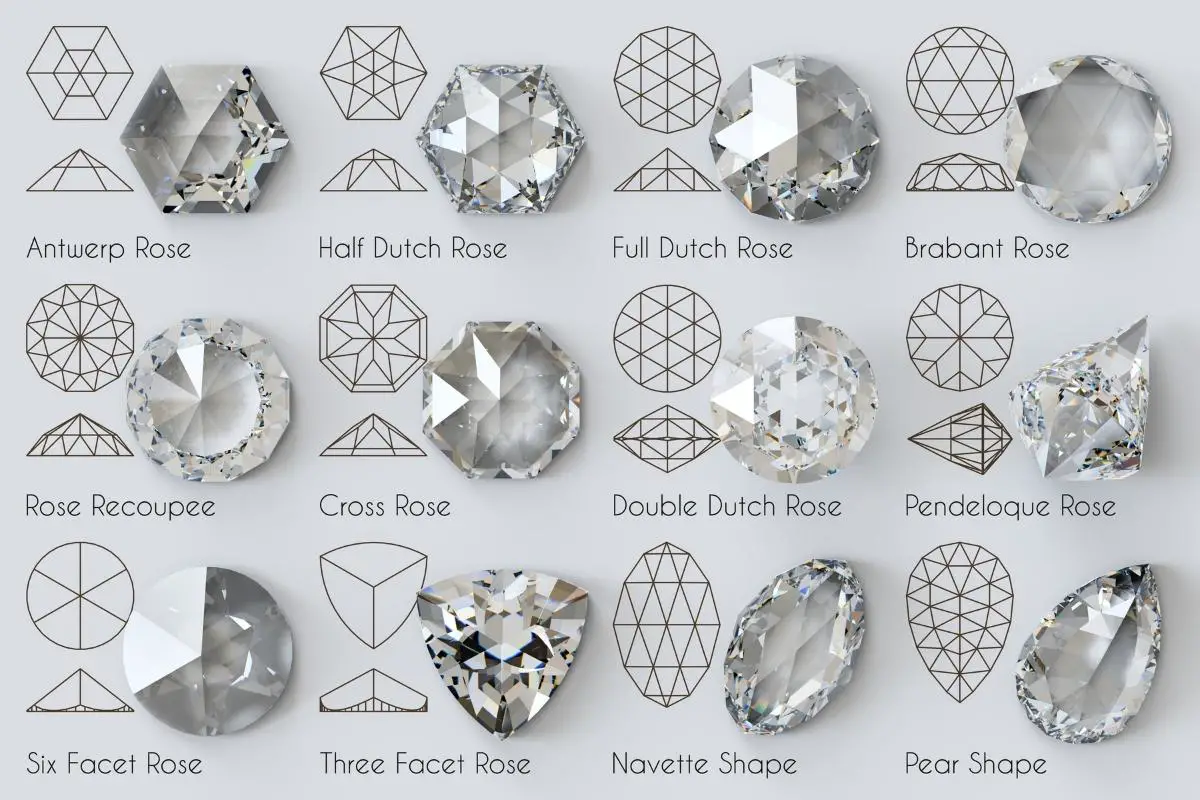
This style of cut can be applied to ovals, pears, marquise, anything you can imagine. Most commonly seen as round cuts, but can be anything. In this post we’ll be referring to rose cut rounds, so the comparison will be as fair and even as possible.
Rose cuts are antique cuts, brilliants are more modern
The first difference and the one that explains things best is that rose cuts are an older cut than brilliant cuts. Rose cuts were in use at least since the 16th century, and were particularly popular in the 18th century. These cuts are far simpler than the brilliant cut, but are an important part of history, and are a direct reflection of the tastes and technology of the time.
Rose cuts fell out of favor by 1900 when the industrial revolution allowed lapidaries to produce finer, more complex cuts which eventually led to the development of the brilliant cut.
The brilliant cut, specifically the round one, was developed by a mathematician. It was derived from the old European cut, itself derived from the old mine cut, itself derived from the old single cut, which in turn was derived from the old pointed cut. The aim of the brilliant cut was to produce as much sparkle within a diamond as mathematically possible, by taking into account a diamond’s refractive index (2.42).
So while the rose cut is an antique cut, the brilliant cut is an arguably modern one, the result of math and tech advancement. Both are beautiful and have a unique charm.
Read also: Morganite VS Moissanite
Brilliants sparkle much more than rose cuts
Both brilliants and rose cuts throw flashes of light, but they do this very differently. While a brilliant reflects the light within its pavilion and then directs if back through the table, the rose cut leaks light. This is due to it not having a pavilion at all, and once the light enters through the domed crown, it sparkles very weakly.
With a rose cut your best chance is to view it at an angle, a bit from the side. There the light bounces at more of an angle and you will see a bit more sparkle. Unfortunately it sparkles less than a typical step cut, so if something dazzling is what you’re looking for, the classic rose cut is not the answer.
You may instead try the double Dutch rose cut, which has both sides look like the crown (domed, faceted, so there is no flat back, and far less light leakage).
Rose cuts appear larger, wider than brilliant cuts
Since rose cuts rely on the spread of the ‘rose’ it will always appear larger than a brilliant cut, when you compare two 1ct diamonds. This is because the rose cut carries most of its weight in its diameter or spread, while the brilliant cut carries its weight in the pavilion.
So if you’re looking for a diamond that looks larger, then the rose cut is definitely a good choice.
Brilliants are far easier to find than rose cuts
There is a significant down side to rose cuts though, they are far less popular and common than brilliant cuts. Even the classic round rose cut is hard to source, and if you’re intending to wear one of them you will need to be patient as the search may be a bit long. They’re much more affordable than brilliant cuts, since they’re less popular and sparkle less, so you can get a larger one or several if your budget allows.
If you’re looking for ready-made engagement rings, you will find plenty of versions with a round brilliant. If you want a pre-made round rose, you may have to contact private jewelers or goldsmiths, or search on sites like Etsy for a handmade one.
Read also: Emerald VS Oval Cut Diamonds
Rose cuts show color and clarity issues, brilliants can hide them
Rose cut diamonds have wide, triangular facets, and the ones where the table would be are the largest. Couple this with the completely flat back, and you get a diamond that has something very similar to a window effect, allowing you to see clearly into and sometimes even through it, like a step cut.
This translates into immediately noticing any significant inclusion or color tone. A brilliant cut has many tiny facets that act like mirrors and hide the vast majority of inclusions, and often an entire color grade too.
So if you’re someone who likes their diamonds top look clean, clear, and colorless then you have two options. Either source a rose cut that is reasonably clear (like a VVS2) and with a G color, or get a round brilliant that can go as low as VS2 and I in color.
Brilliant cuts are usually high set, rose cuts can be set low
Whenever you get your diamond, you will have to set it. Your setting is an important part of the ring design, so let’s see what you should keep in mind.
Are you someone who works with their hands a lot ? Are you sometimes clumsy ? Do you tend to get your jewelry stuck on clothes or your hair ? The perhaps a low profile setting may work best for you, in which case a rose cut is perfect. The rose cut can be placed almost directly onto the ring shank, and this is one of the lowest settings possible. It will look good with prongs, but a bezel might help more, and perhaps a milgrain bezel would look even better.
Round brilliants can also be set fairly low, but the lowest setting for a round brilliant is still significantly taller than any rose cut setting, precisely because the brilliant has a pavilion which raises it.

I’m the main author for jewelrymaterialguide.com. I started this site after we did tons of research before our wedding and noticed that there is information about rings, jewelry, and so on that is really hard to find on the internet.

